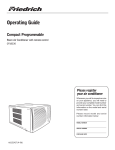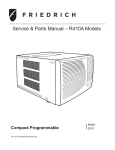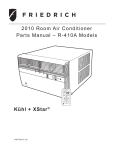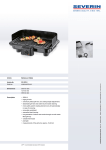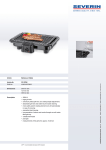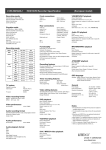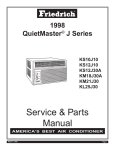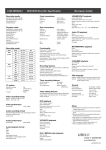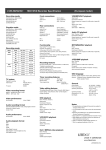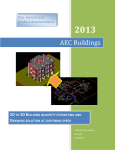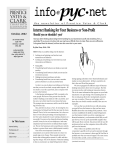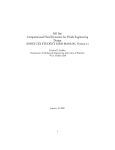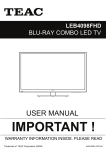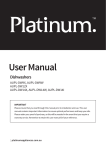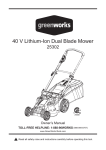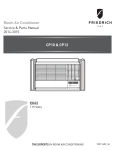Download Service and Parts Manual
Transcript
Service & Parts Manual 2007 Compact Programmable Models CP14N10 CP18N30 CP24N30 CP-14-18-24-Svc-Prts-07 (3-07) Table of Contents Performance Data ........................................................................................................................................................................ 3 Outer Component Identification ................................................................................................................................................... 4 Installation Dimensions ................................................................................................................................................................ 5 Wiring Diagrams ........................................................................................................................................................................... 6 Functional Component Definitions ...............................................................................................................................................7 Refrigeration System Sequence of Operation ............................................................................................................................ 8 Sealed Refrigeration System Repairs .................................................................................................................................... 9-12 Troubleshooting ..................................................................................................................................................................... 13-18 Part Diagrams and Part Lists................................................................................................................................................19-23 Warranty ..................................................................................................................................................................................... 24 The information contained in this manual is intended for use by a qualified service technician who is familiar with the safety procedures required in installation and repair, and who is equipped with the proper tools and test instruments. Installation or repairs made by unqualified persons can result in hazards subjecting the unqualified person making such repairs to the risk of injury or electrical shock which can be serious or even fatal not only to them, but also to persons being served by the equipment. If you install or perform service on equipment, you must assume responsibility for any bodily injury or property damage which may result to you or others. Friedrich Air Conditioning Company will not be responsible for any injury or property damage arising from improper installation, service, and/or service procedures. 2 Specifications and Technical Parameters Model CP14N10 CP18N30 Function COOLING COOLING COOLING 115V ~ 230/208V~ 230/208V~ Rated Voltage CP24N30 Rated Frequency 60Hz 60Hz 60Hz Total Capacity (Btu/h) 14000 18000/17600 23500/23100 Power Input (W) 1430 1850/1810 2740/2710 Rated Input (W) 1540 2478 3538 15 12.57 18.09 Air Flow Volume (CFM) (H) 458.8 458.8 617.6 Dehumidifying Volume (pints/h) 3.38 4.65 8.46 EER / C.O.P BTU/W.H) 9.8 9.7/9.7 8.6/8.5 Rated Current (A) Energy Class Fan Type-Piece Diameter-Length (inch) Indoor Side Evaporator Pipe Diameter (inch) Coil length (l) x height (H) x coil width (L) Compressor Type / / / Centrifugal flow fan – 1 Centrifugal flow fan – 1 Centrifugal flow fan – 1 φ7.93 X 4.31 φ7.93 X 4.31 φ8.82 X 4.31 Aluminum fin-copper tube Aluminum fin-copper tube Aluminum fin-copper tube φ0.276 φ0.276 φ0.276 16.61 X 15 X 1 16.61 X 15 X 1 16.61 X 15 X 1 ROTARY ROTARY ROTARY 58 42 56 10.9 7.45 11.7/11.0 2425/2480 L.R.A. (A) Compressor RLA(A) Compressor Power Input(W) Outdoor Side Overload Protector Working Temp Range (ºF) Condenser Fan Type-Piece Fan Diameter (inch) Fan Motor Speed (rpm) (H/M/L) 1182 1700 MRA13425-12007 MRA98982-9200 Built in 50º-115º 50º-115º 50º-115º Aluminum fin-copper tube Aluminum fin-copper tube Aluminum fin-copper tube Axial fan –1 Axial fan –1 Axial fan –1 φ15.59 φ15.59 φ15.59 900/780/730 900/780/730 1000/900/800 Output of Fan Motor (W) Fan Motor RLA(A) Fan Motor Capacitor (uF) 200 200 190 3 1.45 1.35 15 MFD 7 MFD 7 MFD Permissible Excessive Operating Pressure for the Discharge Side (Psig) 300 300 300 Permissible Excessive Operating Pressure for the Suction Side (Psig) 150 150 150 Dimension (H/W/D)( inch) 16.85 x 25.98 x 28.46 16.85 x 25.98 x 28.46 16.85 x 25.98 x 29.29 Dimension of Package (H/W/D)( inch) 19.96 x 31.1 x 29.13 19.96 x 31.1 x 29.13 19.69 x 29.29 x 36.22 150/163 150/163 165/183 R22/26.46 R22/27.87 R22/33.51 Net Weight /Gross Weight (Pounds) Refrigerant Charge (Ounce) Performance Data EVAP. AIR TEMP. DEG. F PERFORMANCE DATA* Cooling Discharge Temp. Air Drop F. CP14N10 CP18N30 CP24N30 *Rating Conditions: OPERATING CONDENSER PRESSURES Discharge Suction Super TEMPERATURE Sub-Cooling Temp Temp Heat DEG. F Suction Discharge ELECTRICAL RATINGS Amps Cool Amps Heat 59 21 118 173 56 41 54 78 267 12.1 / 58 22 119 173 66 52 55 77 269 8.3 / 57 23 119 172 66 52 55 77 269 8.5 / 57 23 117 197 60 44 50 75 264 12.3 / 56 24 117 195 57 44 50 75 264 13.1 / R-22 REF. Locked Charge in Rotor Amps OZ. 58 26.5 38.9/42.4 27.9 56A(230V) 33.5 Voltage 115 230 208 230 208 BREAKER FUSE 60 Hertz Amps 15 15 20 80 degrees F, room air temp. & 50% relative humidity, with 95 degree F, outside air temp & 40% relative humidity. 3 Outer Component Identification Models: CP14N10, CP18N30, CP24N30 Cabinet Air inlet louver Front grille Front intake grille Air filter (behind front intake grille) Power cord Control panel cover 4 Installation Dimensions Models: CP14N10, CP18N30, CP24N30 (Top View) Fence / obstruction Over 2' Over 1' Over 1' Wall Or window (Front View) 25.98" Ceiling (Side View) Over 1' Over 1' 16.85" Over 2' Less than 8.66" 5 Wiring Diagrams CP24N30 CP18N30 / CP14N10 6 Functional Component Definitions MECHANICAL COMPONENTS HERMETIC COMPONENTS Vent door Allows introduction of fresh air into the room and/or exhausts stale room air outside (on select models.) Compressor Motorized device used to compress refrigerant through the sealed system. Plenum assembly Diffuser with directional louvers used to direct the conditioned airflow. Check valve A pressure-operated device used to direct the flow of refrigerant to the proper capillary tube, during either the heating or cooling cycle. Blower wheel Attaches to the indoor side of the fan motor shaft and is used for distributing unconditioned, room side air though the heat exchanger and delivering conditioned air into the room. Capillary tube A cylindrical meter device used to evenly distribute the flow of refrigerant to the heat exchangers (coils.) Slinger fan blade Attaches to the outdoor side of the fan motor shaft and is used to move outside air through the condenser coil, while slinging condensate water out of the base pan and onto the condenser coil, thus lowering the temperature and pressures within the coil. ELECTRICAL COMPONENTS Thermostat Used to maintain the specified room side comfort level Capacitor Reduces line current and steadies the voltage supply, while greatly improving the torque characteristics of the fan motor and compressor motor. MoneySaver® switch When engaged, it sends the power supply to the fan motor through the thermostat, which allows for a cycle-fan operation. Fan Motor Dual-shafted fan motor operates the indoor blower wheel and the condenser fan blade simultaneously. Heat anticipator Used to provide better thermostat and room air temperature control. 7 Refrigeration System Sequence of Operation A good understanding of the basic operation of the refrigeration system is essential for the service technician. Without this understanding, accurate troubleshooting of refrigeration system problems will be more difficult and time consuming, if not (in some cases) entirely impossible. The refrigeration system uses four basic principles (laws) in its operation they are as follows: 1. “Heat always flows from a warmer body to a cooler body.” 2. “Heat must be added to or removed from a substance before a change in state can occur” 3. “Flow is always from a higher pressure area to a lower pressure area.” 4. “The temperature at which a liquid or gas changes state is dependent upon the pressure.” The refrigeration cycle begins at the compressor. Starting the compressor creates a low pressure in the suction line which draws refrigerant gas (vapor) into the compressor. The compressor then “compresses” this refrigerant, raising its pressure and its (heat intensity) Temperature. The refrigerant leaves the compressor through the discharge line as a hot high pressure gas (vapor). The refrigerant enters the condenser coil where it gives up some of its heat. The condenser fan moving air across the coil’s finned surface facilitates the transfer of heat from the refrigerant to the relatively cooler outdoor air. When a sufficient quantity of heat has been removed from the refrigerant gas (vapor), the refrigerant will “condense” (i.e. change to a liquid). Once the refrigerant has been condensed (changed) to a liquid it is cooled even further by the air that continues to flow across the condenser coil. The RAC design determines at exactly what point (in the condenser) the change of state (i.e. gas to a liquid) takes place. In all cases, however, the refrigerant must be totally condensed (changed) to a liquid before leaving the condenser coil. The refrigerant leaves the condenser coil through the liquid line as a warm high pressure liquid. It next will pass through the refrigerant drier (if so equipped). It is the function of the drier to trap any moisture present in the system, contaminants, and large particulate matter. The liquid refrigerant next enters the metering device. The metering device is a capillary tube. The purpose of the metering device is to “meter” (i.e. control or measure) the quantity of refrigerant entering the evaporator coil. 8 In the case of the capillary tube this is accomplished (by design) through size (and length) of device, and the pressure difference present across the device. Since the evaporator coil is under a lower pressure (due to the suction created by the compressor) than the liquid line, the liquid refrigerant leaves the metering device entering the evaporator coil. As it enters the evaporator coil, the larger area and lower pressure allows the refrigerant to expand and lower its temperature (heat intensity). This expansion is often referred to as “boiling”. Since the unit’s blower is moving Indoor air across the finned surface of the evaporator coil, the expanding refrigerant absorbs some of that heat. This results in a lowering of the indoor air temperature, hence the “cooling” effect. The expansion and absorbing of heat cause the liquid refrigerant to evaporate (i.e. change to a gas). Once the refrigerant has been evaporated (changed to a gas), it is heated even further by the air that continues to flow across the evaporator coil. The particular system design determines at exactly what point (in the evaporator) the change of state (i.e. liquid to a gas) takes place. In all cases, however, the refrigerant must be totally evaporated (changed) to a gas before leaving the evaporator coil. The low pressure (suction) created by the compressor causes the refrigerant to leave the evaporator through the suction line as a cool low pressure vapor. The refrigerant then returns to the compressor, where the cycle is repeated. Refrigerant System Components Suction Line Evaporator Coil Discharge Line Condenser Coil Compressor Metering Device Refrigerant Dryer Refrigerant Drier Liquid Line Sealed Refrigeration System Repairs IMPORTANT ANY SEALED SYSTEM REPAIRS TO COOL-ONLY MODELS REQUIRE THE INSTALLATION OF A LIQUID LINE DRIER. ALSO, ANY SEALED SYSTEM REPAIRS TO HEAT PUMP MODELS REQUIRE THE INSTALLATION OF A SUCTION LINE DRIER. EQUIPMENT REQUIRED 1. 2. 3. 4. 5. 6. 7. 8. 9. 10. 11. Voltmeter Ammeter Ohmmeter E.P.A. Approved Refrigerant Recovery System. Vacuum Pump (capable of 200 microns or less vacuum.) Acetylene Welder Electronic Halogen Leak Detector (G.E. Type H-6 or equivalent.) Accurate refrigerant charge measuring device such as: a. Balance Scales - 1/2 oz. accuracy b. Charging Board - 1/2 oz. accuracy High Pressure Gauge - (0 - 400 lbs.) Low Pressure Gauge - (30 - 150 lbs.) Vacuum Gauge - (0 - 1000 microns) HERMETIC COMPONENT REPLACEMENT cont’d 6. 7. 8. 9. 10. 11. EQUIPMENT MUST BE CAPABLE OF: 1. 2. 3. 4. 5. Recovery CFC’s as low as 5%. Evacuation from both the high side and low side of the system simultaneously. Introducing refrigerant charge into high side of the system. Accurately weighing the refrigerant charge actually introduced into the system. Facilities for flowing nitrogen through refrigeration tubing during all brazing processes. HERMETIC COMPONENT REPLACEMENT The following procedure applies when replacing components in the sealed refrigeration circuit or repairing refrigerant leaks. (Compressor, condenser, evaporator, capillary tube, refrigerant leaks, etc.) 1. 2. 3. 4. 5. Recover the refrigerant from the system at the process tube located on the high side of the system by installing a line tap on the process tube. Apply gauge from process tube to EPA approved gauges from process tube to EPA approved recovery system. Recover CFC’s in system to at least 5%. Cut the process tube below pinch off on the suction side of the compressor. Connect the line from the nitrogen tank to the suction process tube. Drift dry nitrogen through the system and un-solder the more distant connection first. (Filter drier, high side process tube, etc.) Replace inoperative component, and always install a new filter drier. Drift dry nitrogen through the system when making these connections. Pressurize system to 30 PSIG with proper refrigerant and boost refrigerant pressure to 150 PSIG with dry nitrogen. Leak test complete system with electric halogen leak detector, correcting any leaks found. Reduce the system to zero gauge pressure. Connect vacuum pump to high side and low side of system with deep vacuum hoses, or copper tubing. (Do not use regular hoses.) Evacuate system to maximum absolute holding pressure of 200 microns or less. NOTE: This process can be accelerated by use of heat lamps, or by breaking the vacuum with refrigerant or dry nitrogen at 5,000 microns. Pressure system to 5 PSIG and leave in system a minimum of 10 minutes. Release refrigerant, and proceed with evacuation of a pressure of 200 microns or less. Break vacuum by charging system from the high side with the correct amount of liquid refrigerant specified. This will prevent boiling the oil out of the crankcase, and damage to the compressor due to over heating. NOTE: If the entire charge will not enter the high side, allow the remainder to enter the low side in small increments while operating the unit. 12. Restart unit several times after allowing pressures to stabilize. Pinch off process tubes, cut and solder the ends. Remove pinch off tool, and leak check the process tube ends. SPECIAL PROCEDURE IN THE CASE OF COMPRESSOR MOTOR BURNOUT 1. Recover all refrigerant and oil from the system. 2. Remove compressor, capillary tube and filter drier from the system. 3. Flush evaporator condenser and all connecting tubing with dry nitrogen or equivalent, to remove all contamination from system. Inspect suction and discharge line for carbon deposits. Remove and clean if necessary. 4. Reassemble the system, including new drier strainer and capillary tube. 5. Proceed with processing as outlined under hermetic component replacement. ROTARY COMPRESSOR SPECIAL TROUBLESHOOTING AND SERVICE Basically, troubleshooting and servicing rotary compressors is the same as on the reciprocating compressor with only one main exception: NEVER, under any circumstances, charge a rotary compressor through the LOW side. Doing so would cause permanent damage to the new compressor. 9 Refrigerant Charging NOTE: BECAUSE THE RAC SYSTEM IS A SEALED SYSTEM, SERVICE PROCESS TUBES WILL HAVE TO BE INSTALLED. FIRST INSTALL A LINE TAP AND REMOVE REFRIGERANT FROM SYSTEM. MAKE NECESSARY SEALED SYSTEM REPAIRS AND VACUUM SYSTEM. CRIMP PROCESS TUBE LINE AND SOLDER END SHUT. DO NOT LEAVE A SERVICE VALVE IN THE SEALED SYSTEM. Proper refrigerant charge is essential to proper unit operation. Operating a unit with an improper refrigerant charge will result in reduced performance (capacity) and/or efficiency. Accordingly, the use of proper charging methods during servicing will insure that the unit is functioning as designed and that its compressor will not be damaged. Too much refrigerant (overcharge) in the system is just as bad (if not worse) than not enough refrigerant (undercharge). They both can be the source of certain compressor failures if they remain uncorrected for any period of time. Quite often, other problems (such as low air flow across evaporator, etc.) are misdiagnosed as refrigerant charge problems. The refrigerant circuit diagnosis chart will assist you in properly diagnosing these systems. An overcharged unit will at times return liquid refrigerant (slugging) back to the suction side of the compressor eventually causing a mechanical failure within the compressor. This mechanical failure can manifest itself as valve failure, bearing failure, and/or other mechanical failure. The specific type of failure will be influenced by the amount of liquid being returned, and the length of time the slugging continues. METHOD OF CHARGING The acceptable method for charging the RAC system is the Weighed in Charge Method. The weighed in charge method is applicable to all units. It is the preferred method to use, as it is the most accurate. The weighed in method should always be used whenever a charge is removed from a unit such as for a leak repair, compressor replacement, or when there is no refrigerant charge left in the unit. To charge by this method, requires the following steps: 1. Install a piercing valve to remove refrigerant from the sealed system. (Piercing valve must be removed from the system before recharging.) 2. Recover Refrigerant in accordance with EPA regulations. 3. Install a process tube to sealed system. 4. Make necessary repairs to system. 5. Evacuate system to 250 - 300 microns or less. 6. Weigh in refrigerant with the property quantity of R-22 refrigerant. 7. Start unit, and verify performance. 8. Crimp the process tube and solder the end shut. Not enough refrigerant (Undercharge) on the other hand, will cause the temperature of the suction gas to increase to the point where it does not provide sufficient cooling for the compressor motor. When this occurs, the motor winding temperature will increase causing the motor to overheat and possibly cycle open the compressor overload protector. Continued overheating of the motor windings and/or cycling of the overload will eventually lead to compressor motor or overload failure. NOTE: In order to access the sealed system it will be necessary to install Schrader type fittings to the process tubes on the discharge and suction of the compressor. Proper refrigerant recovery procedures need to be adhered to as outlined in EPA Regulations. THIS SHOULD ONLY BE ATTEMPTED BY QUALIFIED SERVICE PERSONNEL. 10 Refrigerant Charging UNDERCHARGED REFRIGERANT SYSTEMS An undercharged system will result in poor performance (low pressures, etc.) in both the heating and cooling cycle. low charge, however, frosting and thawing can also be caused by insufficient air over the evaporator. Whenever you service a unit with an undercharge of refrigerant, always suspect a leak. The leak must be repaired before charging the unit. Checks for an undercharged system can be made at the compressor . If the compressor seems quieter than normal, it is an indication of a low refrigerant charge. A check of the amperage drawn by the compressor motor should show a lower reading. (Check the Unit Specification.) After the unit has run 10 to 15 minutes, check the gauge pressures. To check for an undercharged system, turn the unit on, allow the compressor to run long enough to establish working pressures in the system (15 to 20 minutes). During the cooling cycle you can listen carefully at the exit of the metering device into the evaporator; an intermittent hissing and gurgling sound indicates a low refrigerant charge. Intermittent frosting and thawing of the evaporator is another indication of a Gauges connected to system with an undercharge will have low head pressures and substantially low suction pressures. NOTE: Heat pump refrigeration drawing OVERCHARGED REFRIGERANT SYSTEMS Compressor amps will be near normal or higher. Noncondensables can also cause these symptoms. To confirm, remove some of the charge, if conditions improve, system may be overcharged. If conditions don’t improve, Noncondensables are indicated. Whenever an overcharged system is indicated, always make sure that the problem is not caused by air flow problems. Improper air flow over the evaporator coil may indicate some of the same symptoms as an overcharged system. An over charge can cause the compressor to fail, since it would be “slugged” with liquid refrigerant. The charge for any system is critical. When the compressor is noisy, suspect an overcharge, when you are sure that the air quantity over the evaporator coil is correct. Icing of the evaporator will not be encountered because the refrigerant will boil later if at all. Gauges connected to system will usually have higher head pressure (depending upon amount of overcharge). Suction pressure should be slightly higher. 11 Refrigerant Charging RESTRICTED REFRIGERANT SYSTEM A quick check for either condition begins at the evaporator. With a partial restriction, there may be gurgling sounds at the metering device entrance to the evaporator. The evaporator in a partial restriction could be partially frosted or have an ice ball close to the entrance of the metering device. Frost may continue on the suction line back to the compressor. Often a partial restriction of any type can be found by feel, as there is a temperature difference from one side of the restriction to the other. With a complete restriction, there will be no sound at the metering device entrance. An amperage check of the compressor with a partial restriction may show normal current when compared to the unit specification. With a complete restriction the current drawn may be considerably less than normal, as the compressor is running in a deep vacuum (no load). Much of the area of the condenser will be relatively cool since most or all of the liquid refrigerant will be stored there. The following conditions are based primarily on a system in the cooling mode. 12 Troubleshooting a restricted refrigerant system can be difficult. The following procedures are the more common problems and solutions to these problems. There are two types of refrigerant restrictions: Partial restrictions and complete restrictions. • A partial restriction allows some of the refrigerant to circulate through the system. • With a complete restriction there is no circulation of refrigerant in the system. • Restricted refrigerant systems display the same symptoms as a “low-charge condition.” • When the unit is shut off, the gauges may equalize very slowly. • Gauges connected to a completely restricted system will run in a deep vacuum. When the unit is shut off, the gauges will not equalize at all. Cooling Only Room Air Conditioners: Troubleshooting Tips Problem Compressor does not run Possible Cause Low voltage Check voltage at compressor. 115V & 230V units will operate at 10% voltage variance T-stat not set cold enough or inoperative Set t-stat to coldest position. Test t-stat & replace if inoperative Compressor hums but cuts off on B10 overload Hard start compressor. Direct test compressor. If compressor starts, add starting components Open or shorted compressor windings Check for continuity & resistance Open overload Test overload protector & replace if inoperative Open capacitor Test capacitor & replace if inoperative Inoperative system switch Test for continuity in all positions. Replace if inoperative Broken, loose or incorrect wiring Refer to appropriate wiring diagrams to check wiring Problem Fan motor does not run Possible Cause Action Inoperative system switch Test switch & replace if inoperative Broken, loose or incorrect wiring Refer to applicable wiring diagram Open capacitor Test capacitor & replace if inoperative Fan speed switch open Test switch & replace if inoperative Inoperative fan motor Test fan motor & replace if inoperative (be sure internal overload has had time to reset) Problem Does not cool or only cools slightly Action Possible Cause Action Undersized unit Refer to industry standard sizing chart T-stat open or inoperative Set to coldest position. Test t-stat & replace if necessary Dirty filter Clean as recommended in Owner's Manual Dirty or restricted condenser or evaporator coil Use pressure wash or biodegradable cleaning agent to clean Poor air circulation Adjust discharge louvers. Use high fan speed Fresh air or exhaust air door open on applicable models Close doors. Instruct customer on use of this feature Low capacity - undercharge Check for leak & make repair Compressor not pumping properly Check amperage draw against nameplate. If not conclusive, make pressure test 13 Cooling Only Room Air Conditioners: Troubleshooting Tips Problem Unit does not run Possible Cause Fuse blown or circuit tripped Replace fuse, reset breaker. If repeats, check fuse or breaker size. Check for shorts in unit wiring & components Power cord not plugged in Plug it in System switch in "OFF" position Set switch correctly Inoperative system switch Test for continuity in each switch position Loose or disconnected wiring at switch or other components Check wiring & connections. Reconnect per wiring diagram Problem Evaporator coil freezes up Possible Cause Clean as recommended in Owner's Manual Restricted airflow Check for dirty or obstructed coil. Use pressure wash or biodegradable cleaning agent to clean Inoperative t-stat Test for shorted t-stat or stuck contacts Short of refrigerant De-ice coil & check for leak Inoperative fan motor Test fan motor & replace if inoperative Partially restricted capillary tube De-ice coil. Check temp. differential (delta T) across coil. Touch test coil return bends for same temp. Test for low running current Possible Cause 14 Action Excessive heat load Unit undersized. Test cooling performance & replace with larger unit if needed Restriction in line Check for partially iced coil & check temperature split across coil Refrigerant leak Check for oil at silver soldered connections. Check for partially iced coil. Check split across coil. Check for low running amperage T-stat contacts stuck Check operation of t-stat. Replace if contacts remain closed. T-stat incorrectly wired Refer to appropriate wiring diagram Problem T-stat does not turn unit off Action Dirty filter Problem Compressor runs continually & does not cycle off Action Possible Cause Action T-stat contacts stuck Disconnect power to unit. Remove cover of t-stat & check if contacts are stuck. If so, replace t-stat T-stat set at coldest point Turn to higher temp. setting to see if unit cycles off Incorrect wiring Refer to appropriate wiring diagrams Unit undersized for area to be cooled Refer to industry standard sizing chart Cooling Only Room Air Conditioners: Troubleshooting Tips Problem Compressor runs for short periods only. Cycles on overload Possible Cause Overload inoperative. Opens too soon Check operation of unit. Replace overload if system operation is satisfactory Compressor restarted before system pressures equalized Allow a minimum of 2 minutes to allow pressures to equalize before attempting to restart. Instruct customer of waiting period Low or fluctuating voltage Check voltage with unit operating. Check for other appliances on circuit. Air conditioner should be in separate circuit for proper voltage & fused separately Incorrect wiring Refer to appropriate wiring diagram Shorted or incorrect capacitor Check by substituting a known good capacitor of correct rating Restricted or low air flow through condenser coil Check for proper fan speed or blocked condenser Compressor running abnormally hot Check for kinked discharge line or restricted condenser. Check amperage Problem Possible Cause Loss of charge in t-stat bulb T-stat does not turn unit on Problem Water leaks into the room Action Place jumper across t-stat terminals to check if unit operates. If unit operates, replace t-stat. Loose or broken parts in t-stat Check as above Incorrect wiring Refer to appropriate wiring diagram Problem Noisy operation Action Possible Cause Action Poorly installed Refer to Installation Manual for proper installation Fan blade striking chassis Reposition - adjust motor mount Compressor vibrating Check that compressor grommets have not deteriorated. Check that compressor mounting parts are not missing Improperly mounted or loose cabinet parts Check assembly & parts for looseness, rubbing & rattling Possible Cause Action Evaporator drain pan overflowing Clean obstructed drain trough Condensation forming on base pan Evaporator drain pan broken or cracked. Reseal or replace Poor installation resulting in rain entering the room Check installation instructions. Reseal as required Condensation on discharge grille louvers Clean the dirty evaporator coil. Use pressure wash or biodegradable cleaning agent to clean Chassis gasket not installed Install gasket, per Installation manual Downward slope of unit is too steep Refer to installation manual for proper installation 15 Cooling Only Room Air Conditioners: Troubleshooting Tips Problem Possible Cause Sublimation: When unconditioned saturated, outside air mixes with conditioned air, condensation forms on the cooler surfaces Ensure that foam gaskets are installed in between window panes & in between the unit & the sleeve. Also, ensure that fresh air/exhaust vents (on applicable models) are in the closed position & are in tact Downward pitch of installation is too steep Follow installation instructions to ensure that downward pitch of installed unit is no less than 1/4" & no more than 3/8" Restricted coil or dirty filter Clean & advise customer of periodic cleaning & maintenance needs of entire unit Water "spitting" into room Problem Excessive moisture Problem T-stat short cycles Problem Prolonged off cycles (automatic operation) Problem Possible Cause Action Insufficient air circulation thru area to be air conditioned Adjust louvers for best possible air circulation Oversized unit Operate in "MoneySaver" position Inadequate vapor barrier in building structure, particularly floors Advise customer Possible Cause Action T-stat differential too narrow Replace t-stat Plenum gasket not sealing, allowing discharge air to short cycle t-stat Check gasket. Reposition or replace as needed Restricted coil or dirty filter Clean & advise customer of periodic cleaning & maintenance needs of entire unit Possible Cause Action Anticipator (resistor) wire disconnected at t-stat or system switch Refer to appropriate wiring diagram Anticipator (resistor) shorted or open Disconnect plus from outlet. Remove resistor from bracket. Insert plug & depress "COOL" & "FAN AUTOMATIC" buttons. Place t-stat to warmest setting. Feel resistor for temperature. If no heat, replace resistor Partial loss of charge in t-stat bulb causing a wide differential Replace t-stat Possible Cause Action Evaporator drain pan cracked or obstructed Repair, clean or replace as required Water in compressor area Detach shroud from pan & coil. Clean & remove old sealer. Reseal, reinstall & check Obstructed condenser coil Use pressure wash or biodegradable cleaning agent to clean Fan blade/slinger ring improperly positioned Adjust fan blade to 1/2" of condenser coil Outside water leaks 16 Action Heat / Cool Room Air Conditioners: Troubleshooting Tips Problem Room temperature uneven (Heating cycle) Possible Cause Action Heat anticipator (resistor) shorted (on applicable models) Disconnect power to unit. Remove resistor from tstat bulb block. Plus in unit & allow to operate. Feel resistor for heat. If not heat, replace resistor Wide differential - partial loss of t-stat bulb charge Replace t-stat & check Incorrect wiring Refer to appropriate wiring diagram. Resistor is energized during "ON" cycle of compressor or fan. Problem Possible Cause Action Incorrect wiring Refer to appropriate wiring diagram Defrost control timer motor not advancing (applicable models) Check for voltage at "TM" & "TM1" on timer. If no voltage, replace control Defrost control out of calibration (applicable models) If outside coil temperature is 25F or below, & preselected time limit has elapsed, replace defrost control Defrost control contacts stuck If contacts remain closed between terminals "2" & "3" of the defrost control after preselected time interval has passed, replace control Defrost control bulb removed from or not making good coil contact Reinstall & be assured that good bulb to coil contact is made Unit will not defrost Problem Possible Cause Action Exhaust or fresh air door open Check if operating properly. Instruct customer on proper use of control Dirty filter Clean as recommended in Owner's Manual Unit undersized Check heat rise across coil. If unit operates efficiently, check if insulation can be added to attic or walls. If insulation is adequate, recommend additional unit or larger one Outdoor t-stat open (applicable models) T-stat should close at 38°F. Check continuity of control. If temperature is below 38°F, replace control Heater hi-limit control cycling on & off Check for adequate fan air across heater. Check control for open at 160°F & close at 150°F Shorted supplementary heater Ohmmeter check, approx. 32-35 ohms Incorrect wiring Check applicable wiring diagram Does not heat adequately 17 Heat / Cool Room Air Conditioners: Troubleshooting Tips Problem Unit cools when heat is called for Problem Cooling adequate, but heating insufficient 18 Possible Cause Action Incorrect wiring Refer to applicable wiring diagram Defective solenoid coil Check for continuity of coil Reversing valve fails to shift Block condenser coil & switch unit to cooling. Allow pressure to build up in system, then switch to heating. If valve fails to shift, replace valve. Inoperative system switch Check for continuity of system switch Possible Cause Action Heating capillary tube partially restricted Check for partially starved outer coil. Replace heating capillary tube Check valve leaking internally Switch unit several times from heating to cooling. Check temperature rise across coil. Refer to specification sheet for correct temperature rise Reversing valve failing to shift completely; bypassing hot gas De-energize solenoid coil, raise head pressure, energize solenoid to break loose. If valve fails to make complete shift, replace valve. Components Model CP14N10 19 Model CP14N10 No Description 1 2 3 4 5 6 7 8 9 10 11 12 13 14 15 16 17 18 19 20 21 22 23 24 25 26 27 28 29 30 31 32 33 34 35 36 20 Supporter Assy Screw ST4.2X13 Window locking bracket Screw 4X20 Seal strip 1 Seal strip 2 Curtain Assemby Left and Right Right Curtain Left Curtain Cabinet Assy Screw ST4.2X6.5 Screw M4X8 Connect cord Screw M4X5 Washer 4 Screw ST4.2X22 Top Rail Assy Screw ST4X10 Condenser Assy Nut with Washer M10 Washer 10 Fan Blade Shroud, Fan Blade Top Cover Motor Support Motor CJ100U Innerwall Shroud Air Outlet Foam Swing Louver Swing Linkage Motor, Swing Louver Inflectional Axis Swing Support Fresh Air Door Blower Wheel Qty Friedrich Part# 1 7 2 6 1 1 1 1 1 1 6 1 1 1 1 4 1 4 1 1 1 1 1 1 1 1 1 1 1 2 2 1 1 1 1 1 67700200 67700154 67700113 67700151 67700128 67700129 67700201 67700202 67700203 67700204 67700155 67700149 67700170 67700205 67700158 67700153 67700206 67700152 67700207 67700157 67700159 67700117 67700208 67700110 67700112 67700209 67700109 67700127 67700130 67700210 67700124 67700211 67700121 67700125 67700212 67700116 Code Model CP14N10 No Description 37 38 39 40 41 42 43 44 45 46 47 48 49 50 51 52 53 54 55 56 57 58 59 60 61 62 63 64 65 66 67 68 69 70 71 Clapboard of Snail Shell Base Plate of Air Flue Evaporator Assy Sensor Holder Compressor 44B124HXCEF Overload Protector Compressor Gasket Nut with washer M8 Capillary Assy Water Tray Capacitor 15uF/300VAC Capacitor 50uF/450V Relay 841-S-1A-D 110/120V Transformer 41X26.5C Capacitor clamp Main PCB M2A91J Electric box Isolation Washer D Wire Clamp Power cord Receiver Cover Membrane Control Panel Cover A Display Board 2A91J Front Panel Assy Guide Louver Linkage Filter Guide Louver Front Case Front Panel AS Window Remote Cover Chassis Chassis Fixer Remote Control Qty Friedrich Part# 1 1 1 1 1 1 3 3 1 1 1 1 1 1 1 1 1 1 1 1 1 1 1 1 1 1 1 14 1 1 1 1 1 1 1 67700108 67700106 67700103 67700213 67700214 67700215 67700216 67700156 67700217 67700131 67700218 67700219 67700220 67700221 67700114 67700222 67700136 67700223 67700160 67700224 67700225 67700226 67700227 67700228 67700229 67700230 67700231 67700232 67700233 67700234 67700235 67700236 67700237 67700105 67700171 Code 21 Models CP18C30 & CP18N30 No Description 1 2 3 4 5 6 7 8 9 10 11 12 13 14 15 16 17 18 19 20 21 22 23 24 25 26 27 28 29 30 31 32 33 34 35 22 Supporter Assy Self-threading Screw ST4.2x22 Window Locking Bracket Screw 4X20 Seal Strip 1 Seal Strip 2 Curtain Assemby Left and Right Right Curtain Left Curtain Cabinet Assy Self-threading Screw ST4.2X6.5 Screw Assay M4x8 Connect Cord Screw M4X6 Washer 4 Self-threading Screw ST4.2x22 Top Rail Self-threading Screw with Gasket ST4X10 Condenser Assy Nut with Washer M10 Washer 6 Fan Blade Shroud, Fan Blade Upper Clapboard Motor Support Motor CJ100B Innerwall Blower Front Air Outlet Foam 1 Swing Louver Lever of Vertical Guider Swing Motor SM020B Inflectional Axis Cross Beam Fresh Air Door Qty Friedrich Part# 1 7 2 6 1 1 1 1 1 1 6 1 1 1 1 6 1 4 1 1 1 1 1 1 1 1 1 1 1 2 2 1 1 1 1 67700132 67700154 67700113 67700151 67700128 67700129 67700166 67700168 67700167 67700111 67700155 67700149 67700170 67700150 67700158 67700153 67700134 67700152 67700104 67700157 67700159 67700117 67700107 67700110 67700112 67700164 67700109 67700127 67700130 67700120 67700124 67700133 67700121 67700125 67700123 Code Models CP18C30 & CP18N30 No Description 36 37 38 39 40 41 42 43 44 45 46 47 48 49 50 51 52 53 54 55 56 57 58 59 60 61 62 63 64 65 66 67 68 69 70 71 Blower Wheel Front Clapboard of Snail Shell Base Plate of Air Flue Evaporator Assy Insert Block Compressor 2K25S236AHF Overload Protector Compressor Gasket AD7070815 Nut with Washer M8 Capillary Assay Water Tray Capacitor 7uF/450V Capacitor CBB65 40uF/450V(TUV) Relay 841-S-1A-D 200V/240V TUV Power Transformer 41X26.5F Capacitor Clamp Electric box Main PCB J25713J Fixed Clamp Power cord Display Board J25713J Receiver Cover Control Panel Cover Touch Pad Plate Front Panel Assy Guide louver linkage Filter Horizontal air guider1 Horizontal air guider2 Up Filter Guide Down Filter Guide Panel Basepan Chassis Fixer Drain Plug Remote Control Qty Friedrich Part# 1 1 1 1 2 1 1 3 3 1 1 1 1 1 1 1 1 1 1 1 1 1 1 1 1 1 1 8 1 1 1 1 1 1 1 1 67700116 67700108 67700106 67700103 67700141 67700101 67700102 67700161 67700156 67700115 67700131 67700145 67700144 67700147 67700146 67700114 67700136 67700142 67700160 67700169 67700143 67700138 67700137 67700148 67700165 67700122 67700163 67700118 67700119 67700140 67700139 67700135 67700126 67700105 67700162 67700171 Code 23 Components Model CP24N30 24 Model CP24N30 No Description 1 2 3 4 5 6 7 8 9 10 11 12 13 14 15 16 17 18 19 20 21 22 23 24 25 26 27 28 29 30 31 32 33 34 35 36 37 Supporter Assy Screw ST4.2X13 Window locking bracket Screw 4X20 Seal strip 1 Seal strip 2 LT & RT Curtain Assembly Right Curtain Left Curtain Cabinet Assy Screw ST4.2X6.5 Screw M4X8 Connect cord Screw M4X5 Washer 4 Screw ST4.2X22 Top Rail Assy Screw ST4X10 Condenser Assy Nut with Washer M10 Washer 10 Fan Blade Shroud, Fan Blade Top Cover Motor Support Motor CJ100U Innerwall Shroud Air Outlet Foam Swing Louver Swing Linkage Motor, Swing Louver Inflectional Axis Swing Support Fresh Air Door Blower Wheel Blower Front Qty Friedrich Part# 1 7 2 6 1 1 1 1 1 1 6 1 1 1 1 4 1 4 1 1 1 1 1 1 1 1 1 1 1 2 2 1 1 1 1 1 1 67700200 67700154 67700113 67700151 67700128 67700129 67700201 67700202 67700203 67700238 67700155 67700149 67700170 67700205 67700158 67700153 67700206 67700152 67700239 67700157 67700159 67700117 67700208 67700240 67700112 67700241 67700109 67700242 67700130 67700210 67700124 67700133 67700121 67700125 67700212 67700243 67700108 Code 25 Model CP24N30 No Description 38 39 40 41 42 43 44 45 46 47 48 49 50 51 52 53 54 55 56 57 58 59 60 61 62 63 64 65 66 67 68 69 70 71 26 Base Plate of Air Flue Evaporator Assy Sensor Holder Compressor 44B124HXCEF Overload Protector Compressor Gasket Nut with washer M8 Capillary Assy Water Tray Capacitor 15uF/300VAC Capacitor 50uF/450V Relay 841-S-1A-D 110/120V Transformer 41X26.5C Capacitor clamp Main PCB M2A91J Electric box Isolation Washer D Wire Clamp Power cord Receiver Cover Touch Pad Plate Control Panel Cover A Display Board 2A91J Front Panel Assy Guide Louver Linkage Filter Guide Louver Front Case Front Panel AS Window Remote Cover Basepan Chassis Fixer Remote Control Qty Friedrich Part# 1 1 1 1 1 3 3 1 1 1 1 1 1 1 1 1 1 1 1 1 1 1 1 1 1 1 14 1 1 1 1 1 1 1 67700106 67700103 67700213 67700244 67700215 67700216 67700156 67700245 67700131 67700145 67700246 67700147 67700247 67700114 67700248 67700136 67700223 67700160 67700249 67700225 67700226 67700227 67700228 67700229 67700230 67700231 67700232 67700233 67700234 67700235 67700236 67700250 67700105 67700171 Code Friedrich Air Conditioning Company P.O. Box 1540 San Antonio, TX 78295 210.357.4400 www.friedrich.com ROOM AIR CONDITIONERS LIMITED WARRANTY FIRST YEAR ANY PART: If any part supplied by FRIEDRICH fails because of a defect in workmanship or material within twelve months from date of original purchase, FRIEDRICH will repair the product at no charge, provided room air conditioner is reasonably accessible for service. Any additional labor cost for removing inaccessible units and/or charges for mileage related to travel by a Service Agency that exceeds 25 miles one way will be the responsibility of the owner. This remedy is expressly agreed to be the exclusive remedy within twelve months from the date of the original purchase. SECOND THROUGH FIFTH YEAR SEALED REFRIGERANT SYSTEM: If the Sealed Refrigeration System (defined for this purpose as the compressor, condenser coil, evaporator coil, reversing valve, check valve, capillary, filter drier, and all interconnecting tubing) supplied by FRIEDRICH in your Room Air Conditioner fails because of a defect in workmanship or material within sixty months from date of purchase, FRIEDRICH will pay a labor allowance and parts necessary to repair the Sealed Refrigeration System; PROVIDED FRIEDRICH will not pay the cost of diagnosis of the problem, removal, freight charges, and transportation of the air conditioner to and from the Service Agency, and the reinstallation charges associated with repair of the Sealed Refrigeration System. All such cost will be the sole responsibility of the owner. This remedy is expressly agreed to be the exclusive remedy within sixty months from the date of the original purchase. APPLICABILITY AND LIMITATIONS: This warranty is applicable only to units retained within the Fifty States of the U.S.A., District of Columbia, and Canada. This warranty is not applicable to: 1. 2. 3. Air filters or fuses. Products on which the model and serial numbers have been removed. Products which have defects or damage which results from improper installation, wiring, electrical current characteristics, or maintenance; or caused by accident, misuse or abuse, fire, flood, alterations and/or misapplication of the product and/or units installed in a corrosive atmosphere, default or delay in performance caused by war, government restrictions or restraints, strikes, material shortages beyond the control of FRIEDRICH, or acts of God. OBTAINING WARRANTY PERFORMANCE: Service will be provided by the FRIEDRICH Authorized Dealer or Service Organization in your area. They are listed in the Yellow Pages. If assistance is required in obtaining warranty performance, write to: Room Air Conditioner Service Manager, Friedrich Air Conditioning Co., P.O. Box 1540, San Antonio, TX 78295-1540. LIMITATIONS: THIS WARRANTY IS GIVEN IN LIEU OF ALL OTHER WARRANTIES. Anything in the warranty notwithstanding, ANY IMPLIED WARRANTIES OF FITNESS FOR PARTICULAR PURPOSE AND/OR MERCHANTABILITY SHALL BE LIMITED TO THE DURATION OF THIS EXPRESS WARRANTY. MANUFACTURER EXPRESSLY DISCLAIMS AND EXCLUDES ANY LIABILITY FOR CONSEQUENTIAL OR INCIDENTAL DAMAGE FOR BREACH OF ANY EXPRESSED OR IMPLIED WARRANTY. NOTE: Some states do not allow limitations on how long an implied warranty lasts, or do not allow the limitation or exclusion of consequential or incidental damages, so the foregoing exclusions and limitations may not apply to you. OTHER: This warranty gives you specific legal rights, and you may also have other rights which vary from state to state. PROOF OF PURCHASE: Owner must provide proof of purchase in order to receive any warranty related services. All service calls for explaining the operation of this product will be the sole responsibility of the consumer. All warranty service must be provided by an Authorized FRIEDRICH Service Agency, unless authorized by FRIEDRICH prior to repairs being made. (10-04) Friedrich Air Conditioning Co. Post Office Box 1540 • San Antonio, Texas 78295-1540 4200 N. Pan Am Expressway • San Antonio, Texas 78218-5212 (210) 357-4400 • FAX (210) 357-4480 www.friedrich.com CP-14-18-24-Svc-Prts-07 (3-07) Friedrich Air Conditioning Co. Post Office Box 1540 • San Antonio, Texas 78295-1540 4200 N. Pan Am Expressway • San Antonio, Texas 78218-5212 (210) 357-4400 • FAX (210) 357-4480 www.friedrich.com Printed in the U.S.A. CP-14-18-24-Svc-Prts-07 (3-07)




























